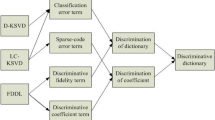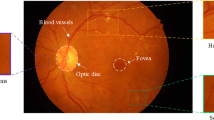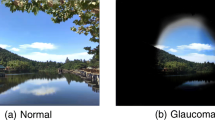Abstract
Glaucoma is a sight-threading disease which can lead to irreversible blindness. Currently, extracting the vertical cup-to-disc ratio (CDR) from 2D retinal fundus images is promising for automatic glaucoma diagnosis. In this paper, we present a novel sparse coding approach for glaucoma diagnosis called adaptive weighted locality-constrained sparse coding (AWLCSC). Different from the existing reconstruction-based glaucoma diagnosis approaches, the weighted matrix in AWLCSC is constructed by adaptively fusing multiple distance measurement information between the reference images and the testing image, making our approach more robust and effective to glaucoma diagnosis. In our approach, the disc image is firstly extracted and reconstructed according to the proposed AWLCSC technique. Then, with the usage of the obtained reconstruction coefficients and a series of reference disc images with known CDRs, the CDR of the testing disc image can be automated estimation for glaucoma diagnosis. The performance of the proposed AWLCSC is evaluated on two publicly available DRISHTI-GS1 and RIM-ONE r2 databases. The experimental results indicate that the proposed approach outperforms the state-of-the-art approaches.

The flowchart of the proposed approach for glaucoma diagnosis.







Similar content being viewed by others
References
Xu Y et al (2013) Efficient reconstruction-based optic cup localization for glaucoma screening. In: International conference on medical image computing and computer-assisted intervention. Springer, Berlin, Heidelberg, pp 445–452
Chakravarty A, Sivaswamy J (2016) Glaucoma classification with a fusion of segmentation and image-based features. In: 2016 IEEE 13th international symposium on biomedical imaging (ISBI). IEEE, pp 689–692
Cheng J, Liu J, Xu Y, Yin F, Wong DWK, Tan NM, Tao D, Cheng CY, Aung T, Wong TY (2013) Superpixel classification based optic disc and optic cup segmentation for glaucoma screening. IEEE Trans Med Imaging 32(6):1019–1032
dos Santos Ferreira Marcos V et al (2018) Convolutional neural network and texture descriptor-based automatic detection and diagnosis of glaucoma. Expert Syst Appl 110:250–263
Wang S, Yu L, Yang X, Fu CW, Heng PA (2019) Patch-based output space adversarial learning for joint optic disc and cup segmentation. IEEE Trans Med Imaging 99:1–1. https://doi.org/10.1109/TMI.2019.2899910
Wong DWK et al (2009) Intelligent fusion of cup-to-disc ratio determination methods for glaucoma detection in ARGALI. In: Engineering in medicine and biology society, 2009. EMBC 2009. Annual International Conference of the IEEE. IEEE, pp 5777–5780
Xu Y et al (2011) Sliding window and regression based cup detection in digital fundus images for glaucoma diagnosis. In: International conference on medical image computing and computer-assisted intervention. Springer, Berlin, Heidelberg, pp 1–8
Damon WWK et al (2012) Automatic detection of the optic cup using vessel kinking in digital retinal fundus images. In: 2012 9th IEEE international symposium on biomedical imaging (ISBI). IEEE, pp 1647–1650
Cheng J, Yin F, Wong DWK, Tao D, Liu J (2015) Sparse dissimilarity-constrained coding for glaucoma screening. IEEE Trans Biomed Eng 62(5):1395–1403
Wang J et al (2010) Locality-constrained linear coding for image classification. In: 2010 IEEE conference on computer vision and pattern recognition (CVPR). IEEE, pp 3360–3367
Fang X et al (2015) Learning a nonnegative sparse graph for linear regression. IEEE Trans Image Process 24:2760–2771
Cai D et al (2011) Graph regularized nonnegative matrix factorization for data representation. IEEE Trans Pattern Anal Mach Intell 33:1548–1560
Yi Y, Qiao S, Zhou W, Zheng C, Liu Q, Wang J (2018) Adaptive multiple graph regularized semi-supervised extreme learning machine. Soft Comput 22(11):3545–3562
Zheng C, Zhao R, Liu F, Kong J, Wang J, Bi C, Yi Y (2018) Dimensionality reduction via multiple locality-constrained graph optimizations. IEEE Access 6:54479–54494
Yu K et al (2009) Nonlinear learning using local coordinate coding. In: Advances in neural information processing systems 2223–2231
Wei CP, Chao YW, Yeh YR, Wang YCF (2013) Locality-sensitive dictionary learning for sparse representation based classification. Pattern Recogn 46:1277–1287
Chao YW et al (2011) Locality-constrained group sparse representation for robust face recognition. In: 18th IEEE international conference on image processing (ICIP). IEEE, pp 761–764
Zheng M et al (2011) Graph regularized sparse coding for image representation. IEEE Trans Image Process 20:1327–1336
Min H, Liang M, Luo R, Zhu J (2016) Laplacian regularized locality-constrained coding for image classification. Neurocomputing 171:1486–1495
Yao T et al (2015) Discovering commonness and specificness for human action recognition. In: The 2nd ACM international workshop on human-centered event understanding from multimedia. ACM, pp 7–12
Wang S, Fu Y (2015) Locality-constrained discriminative learning and coding. In: IEEE conference on computer vision and pattern recognition workshops. IEEE, pp 17–24
Efron B et al (2004) Least angle regression. Ann Stat 32(2):407–499
Dornaika F, Bosaghzadeh A (2015) Adaptive graph construction using data self-representativeness for pattern classification. Inf Sci 325:118–139
Cai D, He X, Han J (2005) Document clustering using locality preserving indexing. IEEE Trans Knowl Data Eng 17:1624–1637
Tang K, Liu R, Su Z, Zhang J (2014) Structure-constrained low-rank representation. IEEE Trans Neural Netw Learn Syst 25:2167–2179
Kwak N (2008) Principal component analysis based on L1-norm maximization. IEEE Trans Pattern Anal Mach Intell 30:1672–1680
Shen F, Tang Z, Xu J (2013) Locality constrained representation based classification with spatial pyramid patches. Neurocomputing 101:104–115
Zhou W et al (2017) Automatic optic disc boundary extraction based on saliency object detection and modified local intensity clustering model in retinal images. IEICE Trans Fundam Electron Commun Comput Sci E100. A(9):2069–2072
Abdullah AS et al (2018) A novel method for retinal optic disc detection using bat meta-heuristic algorithm. Med Biol Eng Comput 1–10
Azzopardi G, Strisciuglio N, Vento M, Petkov N (2015) Trainable cosfire filters for vessel delineation with application to retinal images. Med Image Anal 19(1):46–57
Yin F et al (2012) Automated segmentation of optic disc and optic cup in fundus images for glaucoma diagnosis. In: 2012 25th international symposium on computer-based medical systems (CBMS). IEEE, pp 1–6
Liu J et al (2008) Optic cup and disk extraction from retinal fundus images for determination of cup-to-disc ratio. In: IEEE conference on industrial electronics and applications. IEEE, pp 1828–1832
Hoyer PO (2003) Modeling receptive fields with non-negative sparse coding. Neurocomputing 52:547–552
Li P, Bu J, Chen C, He Z, Cai D (2013) Relational multimanifold coclustering. IEEE Trans Cybern 43(6):1871–1881
Cui Y et al (2018) New semi-supervised classification using a multi-modal feature joint L21-norm based sparse representation. Signal Process Image Commun 65:94–106
Yi Y, Bi C, Li X, Wang J, Kong J (2015) Semi-supervised local ridge regression for local matching based face recognition. Neurocomputing 167:132–146
Platt J (1999) Fast training of support vector machines using sequential minimal optimization. In: Advances in Kernel methods. MIT Press
Lin Z, Chen M, Ma Y (2010) The augmented Lagrange multiplier method for exact recovery of corrupted low-rank matrices. arXiv preprint arXiv: 1009. 5055
Rudin W (1976) Principles of mathematical analysis. 3(4.2):1, McGraw-hill New York
Sivaswamy J et al (2015) A comprehensive retinal image dataset for the assessment of glaucoma from the optic nerve head analysis. JSM Biomed Imaging Data Pap 2(1):1004
Fumero F et al (2011) RIM-ONE: an open retinal image database for optic nerve evaluation. In: The 24th international symposium on computer-based medical systems (CBMS). IEEE, pp 1–6
Santos E, Santos L, Veras R, et al (2018) A semiautomatic superpixel based approach to cup-to-disc ratio measurement. 2018 IEEE symposium on computers and communications (ISCC). https://doi.org/10.1109/ISCC.2018.8538765
Dua S, Acharya UR, Chowriappa P, Sree SV (2012) Wavelet-based energy features for glaucomatous image classification. IEEE Trans Inf Technol Biomed 16(1):80–87
Yu S, Xiao D, Frost S, Kanagasingam Y (2019) Robust optic disc and cup segmentation with deep learning for glaucoma detection. Comput Med Imaging Graph 74:61–71
Cover T, Hart P (1967) Nearest neighbor pattern classification. IEEE Trans Inf Theory 13(1):21–27
Roweis S, Saul L (2000) Linear dimensionality reduction by locally linear embedding. Science 290(5500):2323–2326
Olshausen BA, Field DJ (1996) Emergence of simple-cell receptive field properties by learning a sparse code for natural images. Nature 381(6583):607–609
Peng X, Zhang L, Yi Z, Tan KK (2014) Learning locality-constrained collaborative representation for robust face recognition. Pattern Recogn 47(9):2794–2806
Fu H, Cheng J, Xu Y, et al (2018) Joint optic disc and cup segmentation based on multi-label deep network and polar transformation. IEEE transactions on medical imaging. https://doi.org/10.1109/TMI.2018.2791488
Ayub J, Ahmad J, Muhammad J, et al (2016) Glaucoma detection through optic disc and cup segmentation using K-mean clustering. 2016 International conference on computing, electronic and electrical engineering (ICE Cube). https://doi.org/10.1109/ICECUBE.2016.7495212
Funding
This work was supported by the National Natural Science Foundation of China (Nos. 61602221, 61762050, 61603415, 61471101, and 41661083), the Science and Technology Research Project of Jiangxi Provincial Department of Education (No. GJJ160333), the Natural Science Foundation of Jiangxi Province (No. 20171BAB212009), and the Project of Doctoral Foundation of Shenyang Aerospace University (No. 19YB01), Scientific Research Fund Project of Liaoning Provincial Department of Education (No. JYT19040).
Author information
Authors and Affiliations
Corresponding authors
Ethics declarations
Conflict of interest
The authors declare that they have no conflict of interest.
Additional information
Publisher’s note
Springer Nature remains neutral with regard to jurisdictional claims in published maps and institutional affiliations.
Rights and permissions
About this article
Cite this article
Zhou, W., Yi, Y., Bao, J. et al. Adaptive weighted locality-constrained sparse coding for glaucoma diagnosis. Med Biol Eng Comput 57, 2055–2067 (2019). https://doi.org/10.1007/s11517-019-02011-z
Received:
Accepted:
Published:
Issue Date:
DOI: https://doi.org/10.1007/s11517-019-02011-z




